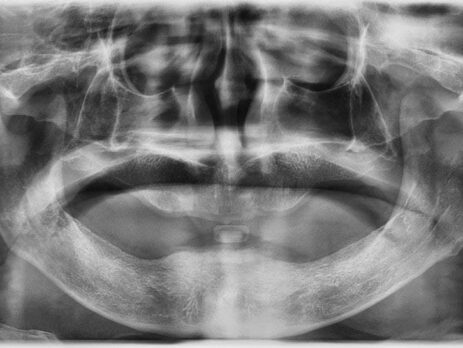What is bone grafting for dental implants?
A bone graft is a surgical procedure (that is routinely performed by Specialist Surgeons) directed towards the replacement and regeneration of jaw bone volume so that dental implants can be placed successfully.
Why is it important to know how much bone is present?
If there’s not enough bone, the dental implant cannot attach to the jaw and will either fail or not last as long as it should. You will need bone grafting if the jaw is too thin (narrow), short (height) or is insufficient around important vital structures (like nerves or sinus cavities), so as to create a solid foundation for your new dental implant.
When might bone grafting for dental implants be necessary?
Unfortunately, bone resorption (the thinning, weakening and deterioration of the bone) is a common side effect of tooth loss and can affect patients of all ages. Before your Specialist Surgeon can make a recommendation regarding dental implants, a thorough evaluation of the volume of your jaw bone is made using X-rays and computed tomography (CT) scans. (The cost of CT scans and X-rays are completely covered by Medicare when requested by Specialist Surgeons).
The data obtained in the CT scans is analysed using 3-dimensional software that allows of a computer-based virtual surgical procedure to be undertaken, without ever having touched the patient. This analysis becomes a complete surgical plan, detailing any potential hazards, and selecting the most ideal implant sizes, sites and angulations, avoiding nerves and sinus cavities, and enables the creation of surgical guides for accurate implant placement.
The surgical plan then becomes the basis for accurate treatment quotations, and most importantly reduced operating time, fewer complications and a faster recovery for the patient.
Bone graft types: What types of bone graft are used?
The best bone graft material is your own bone – also called an autograft (bone taken from your own body). This kind of graft is most often sourced from your own jaw bone during the stage 1 implant procedure (removal of the tooth and placement of the implant). In this way, there is no need for a separate wound (to collect bone from sites outside the mouth), and therefore the healing is much quicker.
Other forms of bone graft material are synthetic (manufactured bone granules and blocks), cow (bovine) bone and human (cadaveric) origin bone.
The choice of bone graft depends on the amount needed and sometimes a mixture of bone graft material is used.
Small to medium volume defects needing bone grafting
Most commonly, one or two teeth are being replaced with implants. In this situation the treatment stages are:
1. Tooth removal + immediate implant placement + bone grafting – The bone graft volume is small and the space around the implant (where the tooth root once was) is filled with sterile, synthetic or demineralised human bone granules, then covered with a protective collagen membrane and stitched together. Over the next few months, the bone graft will heal and integrate with the surrounding bone tissue, preserving the bone height enough to support the dental implant. To ensure the best result, many Specialist Surgeons will use a platelet-rich blood product (Platelet-Rich Fibrin / Platelet-Rich Plasma) to mix with the bone graft, thus reducing the risk of wound infection and speeding the healing process.
2. Implant integration testing – 3 months after implant placement.
3. Implant crown (tooth portion) placement – 1 month after implant testing.
Large volume defects needing a big bone graft
Patients who have had multiple missing teeth for a longer period of time (many years) often experience advanced bone loss. In this case, extensive bone grafting may be necessary to restore the bone. Specialist Surgeons are have developed skills to enable the placement of blocks of bone graft material (often fixed in place with plates and screws) to reconstruct large bone defects. Typically the bone graft will be a combination of products each of different consistency- autologous (from the patient’s jaws, hard palate or hip), combined with human origin (cadaveric) and synthetic products to completely fill in any gaps. Finally, your Specialist Surgeon will put a layer of collagen membranes and PRF / PRP to cover the bone graft material. Finally closing the wound over using stitches. After 3-4 months of healing, the bone graft is healed enough to allow placement of implants.
Will a bone graft affect the length of the treatment?
This ultimately depends the complexity of your treatment.
A small bone graft will not lengthen your recovery time, while more complex bone graft procedures naturally require more healing time in between taking the graft, adding it to your jawbone, and finally, inserting the dental implant.
A large volume bone graft generally adds 3-6 months of healing time to any implant treatment. However, for some people, a bone graft is an essential step.
Recovery from bone graft procedures
After bone graft surgery, you will experience minor to moderate discomfort, including possible bleeding, bruising, and swelling of your gums. For most patients, the pain from bone grafting is limited to 24-48 hours after the procedure.
Things to do during recovery from dental implant and bone grafting procedures:
Pain and swelling relief: Your surgeon will prescribe anti-inflammatories prior to the treatment, which can be continued after treatment, as needed.
Oral care: Use a small, soft bristled tooth brush, don’t floss around the implant, and rinse with non-alcoholic mouthwash 2-3 times a day, post meals. To avoid irritation, make sure to brush gently and carefully around the surgical site.
Eating: Only consume soft foods and try to keep the food away from the surgical site for 3-4 days. Avoid hard, spicy and crunchy foods for the first few weeks and reintroduce these foods slowly.
Check in with your Specialist Surgeon: Review appointments are scheduled for 2 weeks and 3 months post stage 1 implant treatment. If you feel that something isn’t progressing as you though it should, then arrange a review appointment as soon as possible to ensure your implant is healing properly.
Dental Bone Graft Complications
Bone grafting for dental implant treatment is safe and typically has a very high success rate. However, as with all surgical procedures, there is a small risk of:
- Infection
- Allergic reaction
- Rejection of the
- grafting material
- Wound breakdown
- Nerve damage
- Damage to natural
- teeth or blood vessels
- Excessive bleeding
- Numbness, tingling in
- gums, lips, and cheek
- Scarring
- Sinus problems (with upper jaw implants)
- Swelling, pain and bruising
- Abnormal bone development
- Blood clots
If any of these signs concern you or seem excessive, contact your dental surgeon for advice. Selecting a well experienced and reputable Specialist Surgeon should reduce your risk of complications and poor outcomes.
1-2 Sessions
Number of Sessions
20 min.
Session Duration
Local anesthesia
Anesthesia
3-7 Days
Precision
Immediately
Back to Work
3-4 Weeks
Full Recovery
Continuous
Permanence
No
Hospitalization
Attention: *For informational purposes only, please consult your doctor for diagnosis and treatment.
For detailed information, you can contact us via WhatsApp.

